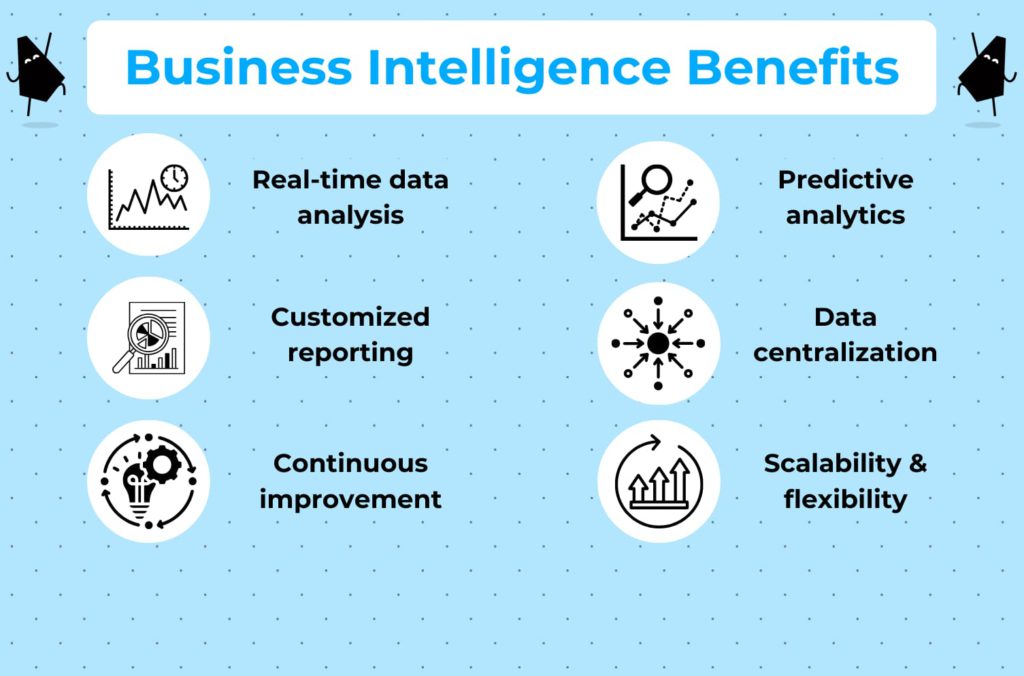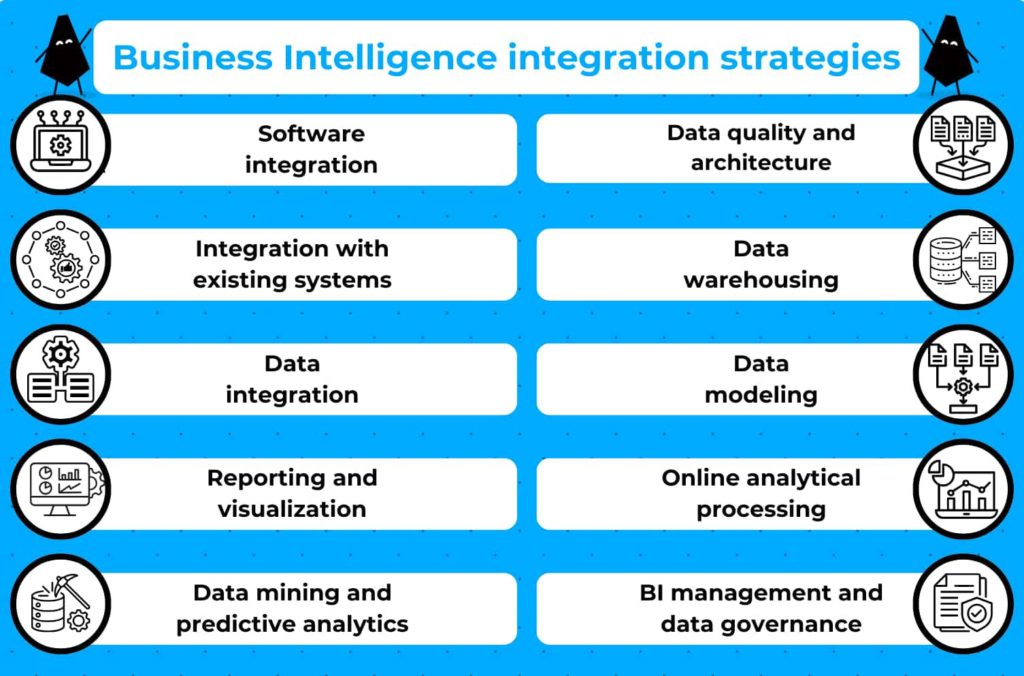Practical strategies for Business Intelligence integration

We bet you feel impressed about finding joy in the little things. But do you seek insights in big data? What if we say in the vast expanse of raw data lies a treasure trove of hidden insights that can illuminate strategic pathways and drive organizational growth?
Indeed, within the labyrinth of data points, there are untapped opportunities. These opportunities can revolutionize decision-making processes, enhance operational efficiency, and ultimately, give ideas on how to refine raw data into dollars.
However, without the tools and methodologies to extract, analyze, and interpret this data effectively, its true potential remains obscured. Here comes data analytics, Business Intelligence (BI), and Artificial Intelligence (AI). Today, we will discuss the powerful BI and its integration. And this article is dedicated to actionable insights seekers and business pushers.
Some interesting figures: According to DataProt’s report, over 33% of large-sized businesses employed decision intelligence in 2023; organizations leave 97% of gathered data unused; businesses using business intelligence are 5 times more likely to reach faster decisions than those that do not.
Make insightful decisions with Business Intelligence & Data Analytics service
Why do you need integrated business intelligence?
Whether expanding into new markets, introducing new products, or accommodating an increasing volume of data, integrated BI solutions offer scalability and flexibility to adapt to changing business requirements. Its visibility capabilities promptly identify trends, opportunities, and potential risks, allowing for timely interventions and adjustments to business strategies. And that’s not all:
- Data centralization streamlines data management processes, ensuring consistency, accuracy, and accessibility of information across the organization;
- Real-time data analysis helps you analyze data in real-time, providing up-to-the-minute insights into key metrics and performance indicators;
- Predictive analytics allows for anticipating future trends and outcomes based on historical data patterns, mitigating risks, and capitalizing on emerging opportunities;
- Customized reporting assists you in creating tailored reports and dashboards tailored to specific user roles and needs in an intuitive and actionable manner.
By integrating BI into organizational operations, you can continually identify areas for optimization and innovation, ensuring continuous improvement and enabling you to leverage insights from data-driven analyses to implement strategic improvements and refine processes.

Best practices to integrate business intelligence components
At this point, the benefits and advantages of business intelligence integration do not end. Here are more BI pros with a breakdown into its components:
Business intelligence software integration
- Tool selection alignment: Align BI tool selection with business needs, technical capabilities, and budget constraints to ensure optimal integration and utilization;
- Free BI tools exploration: Consider utilizing free BI tools that meet the organization’s requirements to reduce costs and facilitate integration;
- Data migration planning: Develop a strategy for migrating data from legacy systems to the new BI software, ensuring minimal disruption to operations and data integrity.
Business intelligence data quality and architecture
- Data infrastructure assessment: Conduct a comprehensive assessment of the organization’s existing data infrastructure to identify strengths, weaknesses, and gaps;
- Data preparation measures: Implement data preparation processes to clean, transform, and integrate data from various sources into a format suitable for analysis and reporting;
- Other data-related evaluations: Evaluate data sources, quality, storage mechanisms, and accessibility. This evaluation aids in identifying areas for improvement.
Business intelligence integration with existing systems
- Data accessibility and usability: Integrate BI with existing systems like enterprise resource planning or customer relationship management software to enhance data accessibility and usability;
- APIs and connectors usage: Utilize APIs, connectors, and middleware to establish seamless integration between BI tools and core business applications to enable real-time data exchange and analysis;
- Compatibility best practice: Ensure compatibility between BI tools and existing systems by conducting thorough testing and validation to minimize integration challenges and ensure smooth data flow.
Business intelligence data warehousing
- Centralized storage: Establish a centralized data warehouse to consolidate structured data from multiple sources, ensuring a single source of truth for analysis;
- Improved data quality: Implement data cleansing and transformation processes within the data warehouse to ensure consistent, high-quality data for analysis;
- Historical analysis: Utilize the historical data stored in the data warehouse to perform trend analysis and identify long-term patterns, informing strategic decision-making.
Business intelligence data integration
- Unified data sources: Utilize data integration tips to consolidate data from disparate sources, including databases, applications, and external sources, ensuring unified data sources for analysis;
- Real-time data processing: Implement real-time data processing capabilities to enable access to the latest information for analysis and decision-making, leveraging integration tools;
- Reduced data redundancy: Integrate data from various sources to reduce redundancy and ensure data consistency across systems, improving data integrity and usability.
Business intelligence data modeling
- Simplified data structures: Design simplified data models that organize complex data into manageable structures, enhancing understanding and facilitating analysis;
- Enhanced query performance: Optimize data models to improve query performance, ensuring efficient data retrieval and analysis for users;
- Scalability best practice: Design scalable data models that can accommodate growing data volumes and evolving business requirements, ensuring long-term usability and adaptability.
Business intelligence reporting & visualization
- Clear data presentation: Utilize data reporting and interactive visualizations to transform raw data into intuitive charts, graphs, and dashboards, enhancing understanding and facilitating decision-making;
- BI dashboard best practice: Use interactive reporting tools that allow users to drill down into data, filter information, and customize dashboards, empowering them to explore data in-depth and derive actionable insights;
- Timely decision-making: Utilize real-time reporting capabilities to monitor key metrics and make timely decisions based on up-to-date information, leveraging reporting and visualization tools.
Online analytical processing (OLAP)
- Multidimensional analysis: Implement OLAP to enable multidimensional analysis of data from various dimensions, facilitating complex analysis and scenario modeling;
- Rapid query response: Utilize OLAP cubes to pre-aggregate data at different levels of granularity, enabling faster query response times and interactive analysis;
- Ad hoc analysis: Leverage OLAP tools to support ad hoc querying, enabling users to explore data dynamically and perform on-the-fly analysis without predefined reports.
Data mining and predictive analytics
- Pattern recognition: Apply data mining techniques to uncover hidden patterns, correlations, and trends within large datasets, enabling organizations to identify insights and make predictive forecasts;
- Predictive modeling: Utilize predictive analytics algorithms to forecast future outcomes based on historical data, enabling organizations to anticipate trends, mitigate risks, and make proactive decisions;
- Personalized approach: Leverage data mining algorithms to power recommendation engines that deliver personalized product recommendations, content suggestions, and marketing offers to users, enhancing customer satisfaction and engagement.
Business Intelligence management and data governance
- Regulatory compliance: Establish data governance frameworks to ensure compliance with data privacy regulations, industry standards, and internal policies, reducing the risk of non-compliance penalties and reputational damage;
- Data protection: Implement data security measures, access controls, and encryption protocols to safeguard sensitive information from unauthorized access, breaches, and cyber threats, adhering to data governance practices;
- BI-managed workflow: Implement regular audit and monitoring mechanisms to track BI usage, data access patterns, and security incidents, enabling proactive management of BI assets.

Conclusion: BI integration will empower your business
So, through BI integration, you can gain the ability to harness the full potential of your data assets, uncover valuable insights, and drive innovation. However, turns out there are so many things to do with your big data to enjoy the BI integration benefits from enhancing decision-making processes to improving business performance. And remember: the more you think, the more data is generated and needs to be turned into insights. It’s time to act.






